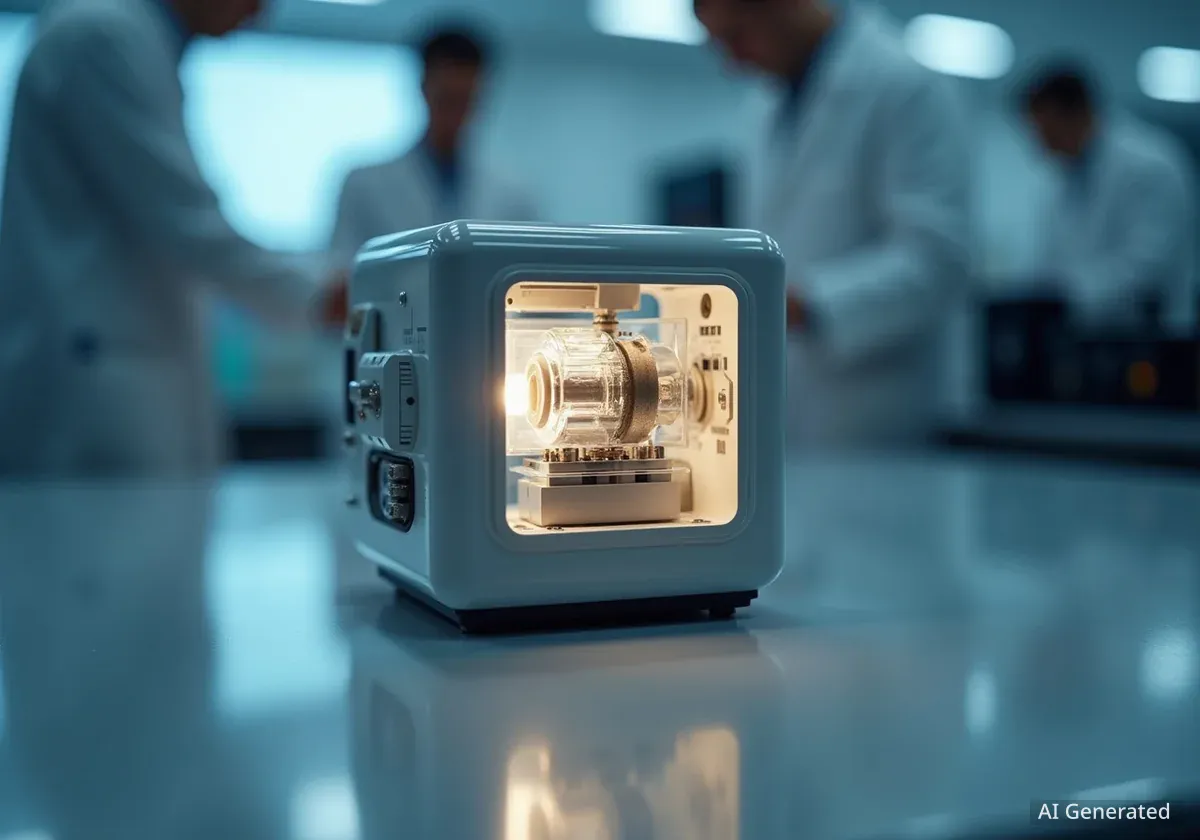A research team at the University of Iowa, supported by NASA, has successfully re-established a critical manufacturing capability for sensors that measure magnetic fields in space. This development is essential for studying space weather, which can disrupt power grids, communication networks, and satellites.
Led by Dr. David Miles, the team has created a new fluxgate magnetometer core, a vital component for space science missions. The project addresses the loss of a legacy manufacturing process previously used for these components, ensuring the United States maintains its ability to produce high-fidelity instruments for space exploration and weather monitoring.
Key Takeaways
- A University of Iowa team has revived the technology to create advanced magnetic field sensors for space missions.
- The project, sponsored by NASA's Heliophysics Strategic Technology Office (HESTO), addresses a gap left by lost legacy manufacturing techniques.
- The new sensor cores will be used in the Space Weather Iowa Magnetometer (SWIM) instrument.
- This technology is crucial for monitoring space weather, which poses a risk to Earth's technological infrastructure.
Addressing a Critical Technology Gap
For decades, scientists have relied on fluxgate magnetometers to measure magnetic fields in space. These instruments are fundamental to understanding the dynamic environment surrounding Earth, including the solar wind and geomagnetic storms. However, a crucial part of these sensors, the ferromagnetic core, depended on a specialized manufacturing process developed for the U.S. Navy.
Over time, the specific knowledge and techniques for producing these high-performance cores became inaccessible to the civilian scientific community. This created a significant technological vulnerability, potentially limiting the ability to build new, advanced instruments for future space science and space weather missions.
What is a Fluxgate Magnetometer?
A fluxgate magnetometer is a highly sensitive device used to measure the strength and direction of magnetic fields. It works by using a ferromagnetic core that is driven in and out of magnetic saturation by an alternating current. The presence of an external magnetic field alters this process, producing a signal that can be precisely measured. These instruments are standard on scientific spacecraft due to their reliability and accuracy.
Recognizing this critical need, NASA's Heliophysics Strategic Technology Office (HESTO) sponsored the University of Iowa team to restore and modernize this capability. The project's goal was not just to replicate the old methods but to create a new, independent, and adaptable manufacturing process from the ground up.
A Modern Approach to Manufacturing
The University of Iowa team, under Dr. Miles's leadership, developed a comprehensive, in-house process that does not rely on any legacy materials or restricted techniques. This modern approach provides complete control over the entire production chain, from raw materials to the final, flight-ready sensor.
From Powder to Precision Component
The manufacturing journey begins with base metal powders. These powders are carefully selected and mixed to create custom alloys with specific magnetic properties tailored to the needs of the sensor. The process involves several precise steps:
- Melting and Alloying: The metal powders are melted together to form a unique ferromagnetic alloy.
- Foil Production: The custom alloy is then rolled into extremely thin foils, a critical step for achieving the required magnetic sensitivity.
- Core Formation: The thin foils are carefully shaped into the specific geometry required for the fluxgate core.
- Heat Treatment: Finally, the formed cores undergo an artificial aging process using controlled heat. This step optimizes their magnetic properties, ensuring stability and high performance in the harsh environment of space.
By managing every stage of this process, the team can ensure the highest quality and consistency for each component produced. This self-sufficiency is vital for the long-term health of U.S. space science programs.
"Having the ability to design and fabricate these critical components in-house gives us unprecedented flexibility," a project spokesperson might note. "We can now explore novel sensor geometries that were previously impossible, opening the door for new types of scientific measurements and more compact instruments for smaller satellites."
SWIM and the Future of Space Weather Monitoring
The first major application for this newly developed technology is the Space Weather Iowa Magnetometer (SWIM). This instrument is designed to provide high-fidelity measurements of magnetic fields as part of missions studying the complex interactions between the Sun and Earth.
The new cores manufactured at the university are integrated directly into the SWIM sensors, which are then paired with custom-designed electronics. This complete system, from the core component to the final instrument, is built and tested by the Iowa team.
The Impact of Space Weather
Severe space weather events, such as coronal mass ejections from the Sun, can have significant consequences on Earth. A 2013 report from Lloyd's of London estimated that a major geomagnetic storm could affect a population of 20-40 million people in the U.S. and result in economic costs ranging from $0.6 to $2.6 trillion.
Protecting Critical Infrastructure
Accurate monitoring of space weather is not just an academic pursuit; it is a matter of national security and economic stability. Geomagnetic storms can induce powerful electrical currents in power grids, potentially causing widespread blackouts. They can also disrupt GPS signals, damage satellites, and interfere with high-frequency radio communications used by airlines and emergency services.
Instruments like SWIM, enabled by the new magnetometer cores, will provide the crucial data needed for space weather forecasting. Improved forecasts give grid operators, satellite controllers, and other stakeholders advance warning, allowing them to take protective measures to mitigate potential damage.
NASA's Strategic Investment in Technology
This project is a prime example of the work supported by NASA's Heliophysics Strategic Technology Office. HESTO's mission is to identify and fund the development of key technologies that will enable future scientific discoveries about the Sun and its influence on the solar system.
By investing in foundational capabilities like the manufacturing of magnetometer cores, NASA ensures that scientists will have the tools they need to answer the next generation of questions in heliophysics. This includes understanding the fundamental processes that drive space weather and protecting our ever-increasing reliance on space-based technology.
The success of the University of Iowa team not only fills a critical gap but also strengthens the nation's technological independence. It paves the way for more resilient and capable scientific missions, ultimately enhancing our ability to predict and prepare for the dynamic and sometimes hazardous conditions in space.





